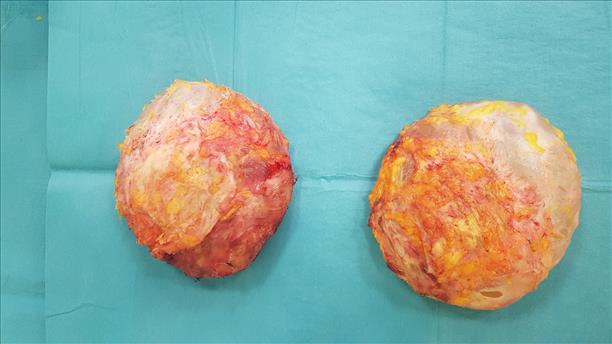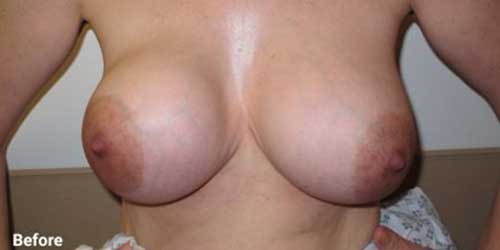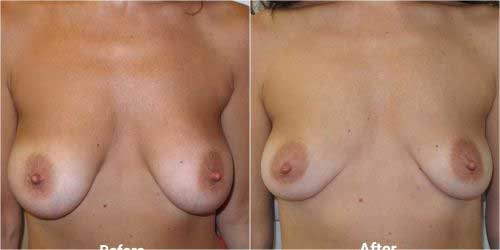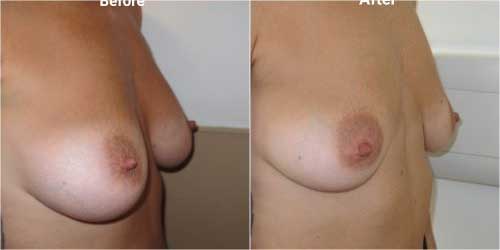
|
|
What is an en-bloc capsulectomy ?
> See article
|

Breast Implant Removal
Breast implant removal without implant replacement is a procedure which some women may consider for a number of reasons. These include the following
- In older women who have had implants all their life and who do not want to consider future surgery and replacements
- In rare cases of women who have suffered complications such as capsular contractures on a repeated basis
- In women who feel they made the wrong decision in their earlier life and now simply want a smaller breast size
- In very rare situations where women may feel they have a reaction to their breast implants causing vague symptoms of ill health
The main concern with breast implant removal is the appearance of the breast following implant removal with the loss in volume and resulting skin laxity. The degree to which such changes occur depend upon the initial size of the breast implant and the level of the nipple which determines the degree of breast drop which may occur after breast implant removal.
There are a number of options available depending on each persons individual circumstances and these include
- Breast implant removal alone
- Breast implant removal combined with a breast uplift
- Breast implant removal and fat transfer to the breast
These options are explained in more detail below.
The other important factor during the breast implant removal is whether the capsule is removed with the breast implant. If the capsule is soft and thin this is not needed but if there is a thick capsule with a contracture a capsulectomy will be required. There are some women who are currently requesting an en-bloc capsulectomy which means the whole capsule is removed in one piece together with the breast implant. This is a more complex procedure which can be offered at the same time.
The consultation for breast implant removal
During your consultation Mr Chana will discuss your reasons for breast implant removal and take a full history about previous surgery. It is helpful to bring with you any details you may have about the existing implant size. This is normally provided at the time of the initial surgery and takes the form of a card with the make and size of the implants in terms of a cubic centimeter size. If you do not have the details it is useful to contact your previous clinic or surgeon.
An examination and measurements will be taken to determine the dimensions and nipple position. After this a full discussion will take place regarding the likely result that would be expected with a straight removal and if any further procedures are required to meet your expectation in terms of the need for a breast uplift or maintaining volume with fat transfer.
The surgery for breast implant removal
A breast implant removal requires a general anaesthetic and the stay in hospital is either a day case or a 1 night stay depending on individual circumstances and extent of surgery required.
The surgery involves removal of the breast implants via the existing scar which in the majority of women is in the crease under the breast. In some women who have had a breast implant insertion initially via the armpit or using a scar around the nipple these approaches cannot be used for implant removal. Under these circumstances a new incision would need to be made in the crease under the under the breast.
During the implant removal the capsule around the breast implant may be removed if it is thick and contracted. Usually such extra surgery means that a drain would be needed.
The recovery following breast implant removal
An implant removal alone without capsulectomy tends to be a relatively pain free procedure. If a capsulectomy is required there is more discomfort but this can be easily controlled with painkillers which are prescribed for you.
In general the recovery and time off work is approximately 1 week although patients undergoing a capsulectomy may need 2 weeks off work. Exercise is not recommended for 6 weeks and during this time a sports bra is recommended.
The risks of breast implant removal
Apart from the scars the other risks can be infection or haematoma. Infection is rare and can be treated with antibiotics. Haematoma from bleeding can be a risk in patients who need a capsulectomy which is why drains are inserted at the time of surgery. Apart from this early risk a minority of women may develop a seroma ( clear fluid) two to three weeks later. This is because there has been a cavity within the breast where body fluid can accumulate. This may absorb by itself or occasionally it may need aspirating with a needle which can be performed in the clinic or at the same time as an ultrasound scan.
Some loss of sensation may occur depending on the extent of surgery. This may improve over time but it may also be permanent especially around the areola.
Some asymmetry may occur but it should be remembered that most women have a variable degree of asymmetry in any case.
Irregularities and indentations can occur especially in situations where a capsulectomy is required and the breast tissue is thin. This is because sometimes loss of some breast tissue is inevitable in the process of removing a thick capsule. It may be possible to correct such issues with secondary surgery using techniques such as fat transfer or skin tightening but sometimes it may not be correctable.
What will my breasts look like after breast implant removal ?
This will depend on individual circumstances and the size of the breast implants. It is always best to wait about 6 months to assess the results since there is a degree of skin shrinkage once the breast implants are removed. In women who have had small breast implants the likelihood is that the breasts should return close to the previous size provided there has been no significant change during any pregnancies and provided the nipple has not dropped the breast will simply lose the volume and projection that was previously provided by the implants. However, breast implants always cause some degree of compression of the existing breast tissue and therefore restoration of the exact same previous breast shape and volume is very unlikely.
In women who previously have had large breast implants there may be a variable degree of skin laxity which along with loss of projection results in some droopiness in the appearance of the breast. For some women this may be acceptable but in others it may require further surgery to optimize the breast shape. This can involve breast uplift surgery or fat transfer to the breast. This is explained in more detail below.
Breast implant removal with breast uplift
This combined surgery is an option in situations where there is a pre-existing droopy breast or in situations where large breast implants are to be removed resulting in an excessive breast drop.
Under these circumstances the above information on breast implant removal and capsulectomies applies but of course there is extra scarring from the breast uplift (mastopexy) procedure. The scar is in the form of an anchor shape and will run around the areola, vertically down below the nipple and horizontally in the crease under the breast. This procedure is essentially the same as that described on the mastopexy page. However, limited scar techniques are usually not applicable due to the degree of breast drop and a full anchor shaped scar is needed in the vast majority of cases.
Since there is a cavity where the breast implant is removed an auto-augmentation technique can be useful to improve the projection of the breast. This uses some of the existing breast tissue which is repositioned centrally under the nipple to enhance the projection whilst at the same time as lifting the nipple.
Also, a breast uplift when performed after an implant removal does have more risks especially with respect to wound healing complications since the tissues may be thinner and more stretched by the breast implant. Although still very rare, there is a higher than usual risk of developing nipple necrosis resulting in a partial or total loss of the nipple. The reason for this is that the breast tissue under the areola keeping the nipple alive is a lot thinner and surgery to reshape and lift the breast can interfere with the already reduced blood supply to the nipple area.
Breast implant removal combined with fat transfer to the breast
In women who would like to restore some volume to their breasts following breast implant removal fat transfer is an option . However, this is only suitable in women who have sufficient fat elsewhere on their body. This technique is described in detail on the webpage for breast fat transfer.
Fat transfer will not simulate the shape of breast implants rather it simply aims to enlarge the existing breast shape. Also, the same degree of enlargement is not possible and it may require more than one fat transfer procedure to achieve the desired results.
This technique may not be ideal in women who have very thin breast tissue when implants are removed as the fat needs to be injected into the breast tissue itself and not into the empty cavity from where the breast implant was removed. In this situation it is best to allow the breast to settle after implant removal and consider fat transfer at a delayed stage usually 6 months later when there is a better chance of the fat integrating into the breast.
-
Breast Implant removal 360cc implants removed


This patient had 360cc breast implants removed and the result is shown at 6 months. The breast tissues have settled and skin retracted very well leaving a very satisfactory shape. There is a small amount of skin laxity which can be seen around the nipple. An uplift is not needed since the nipple has settled very centrally in the breast and is well above the crease under the breast. The cup size reduced from a D cup to B cup.
-
Removal of 350cc breast implants


This patient had 350cc implants 12 years previously. The breast had dropped over time and she did not want implant replacements. An uplift was offered but she did not want to accept any scars on the breast. The result is a reduction in two cup sizes from DD to c cup. Although the nipple position is a little low and the areoala is large this patient was very happy with the result and the fact that an uplift was avoided.
-
Removal of 220cc breast implants


Removal of small implants in a patient with a ptotic breast who did not want to accept the scars of a breast uplift. This explantation has reduced her from a C to a B cup. After explantation the nipple appears quite central in the breast and an uplift avoided with a very satisfactory result.


